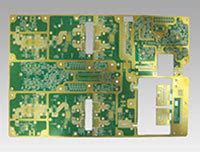Introduction to Rogers PCB Materials
Rogers Corporation is a leading manufacturer of high-performance printed circuit board (PCB) materials. Rogers PCB laminates offer superior electrical properties, thermal management, and mechanical stability for demanding applications in telecommunications, aerospace and defense, automotive, and industrial markets.
The key advantages of Rogers PCB materials include:
- Low dielectric loss
- Excellent thermal conductivity
- Dimensional stability over a wide temperature range
- Reliable performance at high frequencies
- Resistance to moisture absorption
- UL 94 V-0 flammability rating
Types of Rogers PCB laminates
Rogers offers a wide range of PCB laminate materials to meet the specific requirements of different applications. Some of the popular Rogers PCB laminates include:
1. RO4000 Series
The RO4000 series is a glass-reinforced hydrocarbon ceramic laminate designed for high-frequency applications. It offers excellent electrical properties, including low dielectric loss and stable dielectric constant over a wide frequency range.
| Property | RO4003C | RO4350B | RO4360G2 |
|---|---|---|---|
| Dielectric Constant (10GHz) | 3.38 | 3.48 | 6.15 |
| Dissipation Factor (10GHz) | 0.0027 | 0.0037 | 0.0038 |
| Thermal Conductivity (W/mK) | 0.71 | 0.69 | 0.80 |
2. RO3000 Series
The RO3000 series is a ceramic-filled PTFE composite laminate that provides excellent electrical performance and mechanical stability. It is suitable for high-frequency applications that require low insertion loss and reliable performance.
| Property | RO3003 | RO3006 | RO3010 |
|---|---|---|---|
| Dielectric Constant (10GHz) | 3.00 | 6.15 | 10.2 |
| Dissipation Factor (10GHz) | 0.0013 | 0.0025 | 0.0035 |
| Thermal Conductivity (W/mK) | 0.50 | 0.61 | 0.66 |
3. RT/duroid Series
The RT/duroid series is a PTFE-based laminate reinforced with glass microfibers. It offers excellent electrical properties, low moisture absorption, and a low coefficient of thermal expansion (CTE).
| Property | RT/duroid 5870 | RT/duroid 5880 | RT/duroid 6002 |
|---|---|---|---|
| Dielectric Constant (10GHz) | 2.33 | 2.20 | 2.94 |
| Dissipation Factor (10GHz) | 0.0012 | 0.0009 | 0.0012 |
| Thermal Conductivity (W/mK) | 0.22 | 0.20 | 0.60 |
Applications of Rogers PCB
Rogers PCB Materials find applications in various industries due to their superior performance and reliability. Some of the primary applications include:
1. Wireless Communication
- 5G networks
- Cellular base stations
- Satellite communication
- Radar systems
2. Automotive Electronics
- Advanced driver assistance systems (ADAS)
- Autonomous vehicles
- Vehicle-to-everything (V2X) communication
- Wireless charging systems
3. Aerospace and Defense
- Avionics
- Military communication systems
- Radar and surveillance
- Missile guidance systems
4. Industrial and Medical
- High-frequency trading systems
- Industrial automation
- Medical imaging (MRI, CT)
- Wireless medical devices

Rogers PCB Design Considerations
When designing PCBs using Rogers materials, there are several factors to consider for optimal performance:
1. Material Selection
Choose the appropriate Rogers laminate based on the electrical, thermal, and mechanical requirements of your application. Consider factors such as dielectric constant, dissipation factor, thermal conductivity, and CTE.
2. Impedance Control
Ensure proper impedance control by designing transmission lines with the correct width and spacing. Use Rogers’ free impedance calculators and design tools to assist in this process.
3. Thermal Management
Consider the thermal conductivity of the Rogers laminate and design an appropriate thermal management solution, such as using thermal vias or heat spreaders, to dissipate heat effectively.
4. Manufacturing Process
Work closely with your PCB manufacturer to ensure they have experience working with Rogers materials. Some Rogers laminates may require special handling or processing techniques to achieve the best results.
5. Testing and Validation
Perform thorough testing and validation of your Rogers PCB design to ensure it meets the required performance specifications. This may include signal integrity analysis, thermal simulations, and real-world testing.
FAQ
1. What are the main differences between Rogers PCB and FR-4?
Rogers PCB materials offer superior electrical properties compared to standard FR-4 laminates. They have lower dielectric loss, better thermal conductivity, and more stable performance at high frequencies. Rogers laminates are also more expensive than FR-4.
2. Can I mix Rogers and FR-4 materials on the same PCB?
Yes, it is possible to use both Rogers and FR-4 materials on the same PCB. This is often done to balance cost and performance, with Rogers materials used in critical high-frequency areas and FR-4 used in less demanding regions. However, ensure proper design considerations are made for the transition between materials.
3. How do I select the right Rogers material for my application?
To select the appropriate Rogers laminate, consider the electrical, thermal, and mechanical requirements of your application. Factors such as dielectric constant, dissipation factor, thermal conductivity, and CTE should be evaluated. Consult Rogers’ product datasheets and application notes for guidance.
4. Are there any special processing requirements for Rogers PCBs?
Some Rogers laminates may require special processing techniques during PCB manufacturing. For example, RO4000 series materials require a specific surface preparation process called RoHS-compliant oxide alternative process (RCOAP). Work closely with your PCB manufacturer to ensure they have experience working with Rogers materials.
5. How can I ensure the reliability of my Rogers PCB design?
To ensure the reliability of your Rogers PCB design, follow best design practices, such as proper impedance control, effective thermal management, and thorough testing and validation. Work with experienced PCB designers and manufacturers familiar with Rogers materials, and adhere to Rogers’ design guidelines and recommendations.
Conclusion
Rogers PCB materials offer superior performance and reliability for high-frequency and demanding applications across various industries. By understanding the properties and benefits of different Rogers laminates, considering key design factors, and working closely with experienced PCB manufacturers, you can create robust and reliable PCB designs that meet your application’s specific requirements.

No responses yet